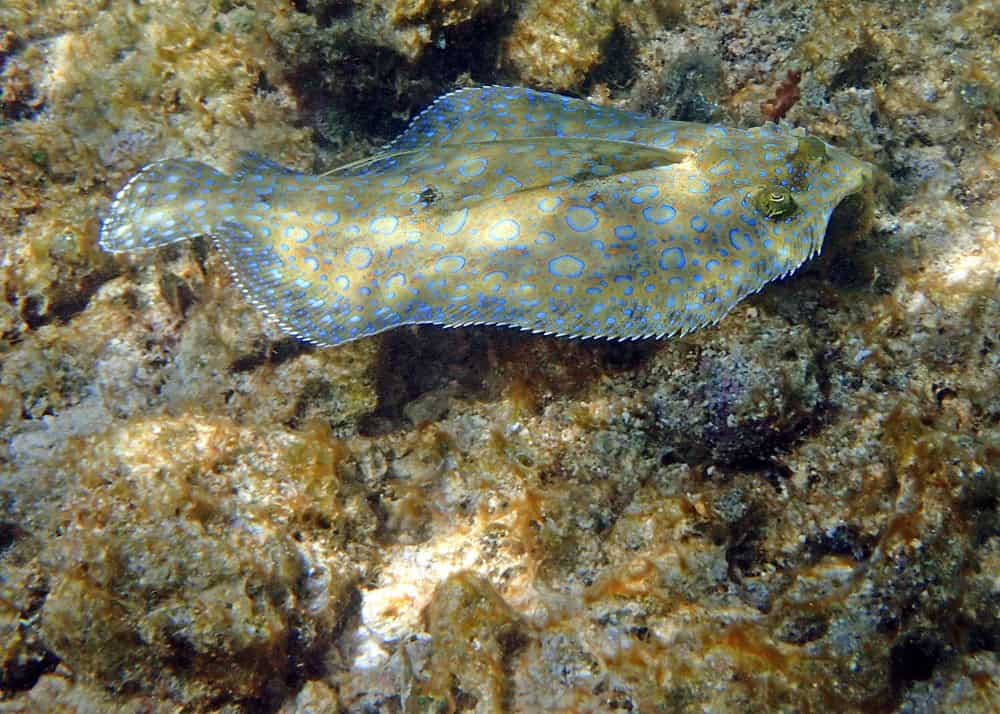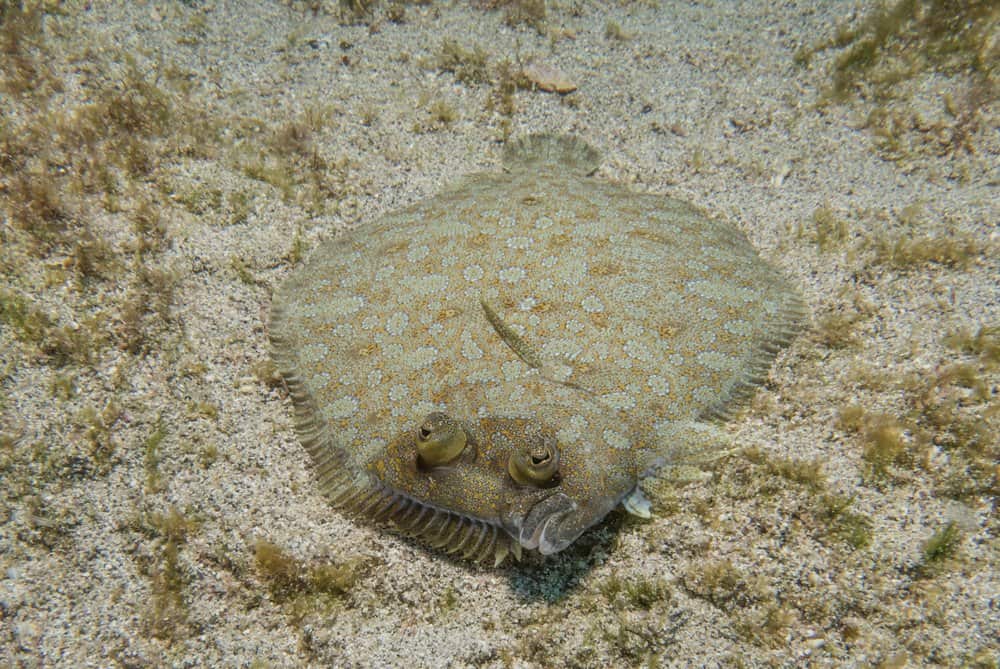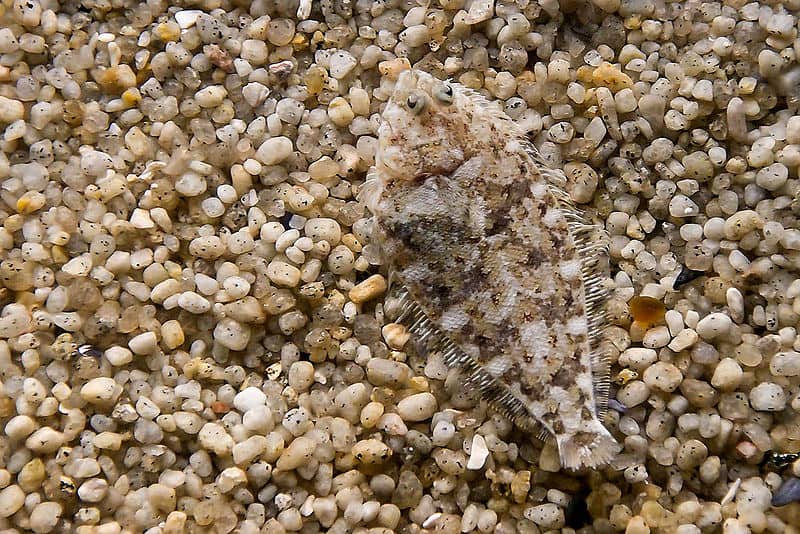Winter flounder and summer flounder are both born like most other fish. They have one eye on each side of their head and a swaying tail that swishes side to side. But before long, they settle to the ocean floor and begin their life as a stealthy bottom dweller. As they lay on one side and settle to the ocean floor, a mysterious transformation takes place. Let’s unveil the metamorphosis that these flounders share, but also take a deep dive into the key differences between winter flounder vs summer flounder.
Comparing Winter Flounder vs Summer Flounder

| Common Name | Winter Flounder | Summer Flounder |
| Scientific Name | Pseudopleuronectes americanus | Paralichthys dentatus |
| Life Expectancy | 15 – 18 years | 12 – 14 years |
| Spawning Habitat | inshore waters | offshore waters |
| Teeth | small, flattened | large, sharp |
| Eyes | right-eyed | left-eyed |
| Color | dark, camouflage | light, camouflage |
| Size | Can grow more than 2 feet long | Can grow up to 3 feet long |
Key Differences Between Winter Flounder and Summer Flounder
The key differences between winter flounder and summer flounder are their preferred spawning habitats and features of their teeth, eyes, and coloring. These look-alike flatfish are classified in different families and differ in their life expectancy.
Winter flounder spawn during the winter and spring in shallow, inshore waters. Summer flounder prefer to spawn at sea in the fall and winter. One has small flattened teeth while the other’s are big and sharp. One has eyes on the right side of their head, the other on the left. Read on to find out the differences between these fish in disguise.
Winter Flounder vs Summer Flounder: Classification

Part of separate families, winter flounder and summer flounder have different teeth and coloring.
©CT Johnson/Shutterstock.com
Both members of the Pleuronectiformes order, summer flounder and winter flounder belong to distinct families.
Winter flounder are members of the Pleuronectidae family, also known as “right-eye flounders.” Their species name is Pseudopleuronectes americanus or American right-eye flounders. They’re one of five species in their genus along with the yellow-striped flounder, cresthead flounder, marbled flounder, and the dark flounder. They’re the only species of the group that inhabits the Atlantic Ocean.
Summer flounder are part of the Paralichthyidae family, who have eyes on their left side. Paralichthys dentatus is their species name. Other species in their genus include the Tropical flounder, Gulf flounder, Brazilian flounder, and Speckled flounder, among others.
Winter Flounder vs Summer Flounder: Size and Lifespan

Winter flounder spawn inshore in shallow waters, while summer flounder prefer to spawn offshore.
©Becky Gill/Shutterstock.com
Summer flounder grow fast in their relatively short life of about 12 to 14 years. Males of the species can grow to be more than 2 feet in length, while females get up to 3 feet. They normally grow to a maximum weight of about 15 pounds, although larger fish have occasionally been reported. The average size of summer flounder when caught is between 2 to 5 pounds. Winter flounder can grow to be more than 2 feet in length in the 15 to 18 years that they live. They have a similar average weight as summer flounder.
Winter Flounder vs Summer Flounder: Range and Spawning Habitat
Like most flatfish, winter flounder spend most of their lives on the bottom of the ocean, or close to it. Here, they can bury themselves to their eyes in sand in an instant to hide from predators. They’re native to the western Atlantic Ocean. Winter flounder are common in estuaries and on the continental shelf of the northwest Atlantic, ranging from the Gulf of St. Lawrence, Canada to North Carolina. They’re the most common shallow-water flounder along the coastal waters of the northeast U.S. “Winter flounder” are cold water fans that enter shallow bays and coves in winter and spring to spawn and stay until the sun warms the water above their preferred temperature.
Summer flounder love to bottom-dwell as well and swim in the same seas of the western Atlantic Ocean, from Nova Scotia to the coast of Florida. They’re most common in the mid-Atlantic region of the U.S. from Cape Cod, Massachusetts to Cape Fear, North Carolina. Like winter flounder, they’re common in the northeast U.S. coast where they’re called fluke. As “summer flounder,” they migrate in the summer or spring, leaving the deep ocean waters to move inshore along beaches, inlets, bays, estuaries, canals, and creeks. They spawn in the fall and early winter when they move offshore. Spawning peaks in October and November when autumn plankton is most abundant for their larvae to feed on.
Winter Flounder vs Summer Flounder: Teeth
Summer flounder possess a large mouth, pronounced jaw and large, sharp teeth. Winter flounder have a small mouth and small, flattened teeth. The species name of summer flounder, Paralichthys dentatus, hints at this major distinction between these two fish. Dentatus is latin for “having sharp teeth with concave edges.”
Winter Flounder vs Summer Flounder: Eyes Placement
Summer flounder are left-eyed flatfish, meaning that both eyes are on the left side of their bodies when viewed from above. They lie on the right side of their flat bodies on the ocean floor. As larvae develop into juveniles, their right eye migrates across the top of their head to the left side. A study presented in the journal of Fish Biology found that the timing of this feat of metamorphosis was temperature-dependent.
Winter flounder have both their eyes on the right side of their body and lie on their left side on the seafloor. Like summer flounder, they’re born with an eye on either side of their head. They settle on the ocean floor and spend their first weeks adapting to life down below. Then, their left eye will migrate to meet the other on the right side.
Winter Flounder vs Summer Flounder: Color

Both winter and summer flounder practice camouflage, but winter flounder are darker.
©Moondigger, CC BY-SA 2.5, via Wikimedia Commons – License
Summer flounder are shades of brown, gray, or drab on top and are white on their bottom sides. Excellent at camouflage, these “chameleons of the sea” can change their coloring. They do this to blend with the texture and color of their surroundings. This gives them protection from predators and allows them to surprise their prey. Their coloring can range from nearly white on white sand through hues of gray, blue, green, orange, pink, and brown to almost black. They often have dark spots on their top sides. Usually, at least five of these spots are arranged in an “X” pattern. Their lateral line tends to have a curve.
Winter flounder have a darker coloring than summer flounder and their lateral line is completely straight. Their coloring also varies with their habitat and can be muddy to reddish-brown, olive green, or dark slate to almost black. As they can be very dark at times, they are sometimes called “Blackback flounder.” Their bottom side is typically white and their fins tinged with pink, red or yellow.
The photo featured at the top of this post is © Gaurav Ruke/Shutterstock.com
Thank you for reading! Have some feedback for us? Contact the AZ Animals editorial team.







